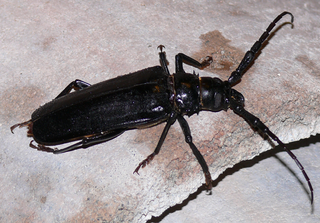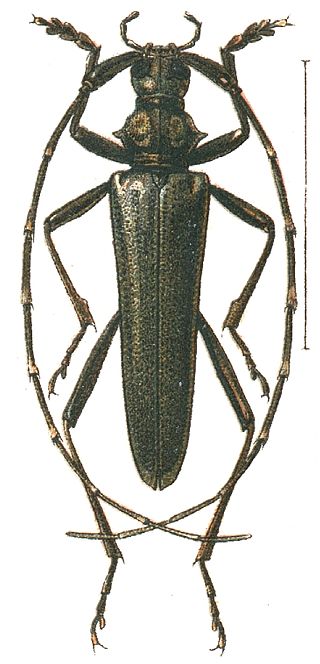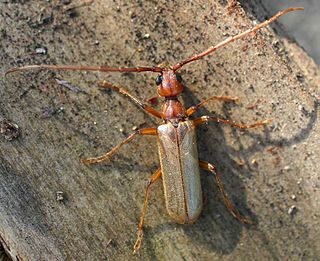Related Research Articles
Fermín Martín-Piera was a Spanish specialist in the taxonomy, systematics, and phylogeny of Scarabaeoidea with special reference to dung beetles.

Derobrachus geminatus is a species of beetle in the family Cerambycidae. For over 100 years, this species was confused with the related species Derobrachus hovorei; essentially all literature prior to 2007 therefore uses the name geminatus for the wrong species, while the true geminatus was known under the junior name Derobrachus forreri. It is an uncommon species but fairly large, reaching 70 mm in length, that can be found from southern Arizona and Texas to Sinaloa and Baja California Sur.

The Disteniidae are a small family of beetles in the superfamily Chrysomeloidea, traditionally treated as a group within the Cerambycidae.

The Vesperidae are a small family of beetles, normally classified within the family Cerambycidae, of heterogeneous aspect but all characterised by larval stages related to roots of herbaceous plants or trees
Ucai is a genus of beetles in the longhorn beetle family, Cerambycidae. It was erected in 2009 with the description of a new species from Brazil. A second species was described in 2014.
Methiini is an obsolete tribe of beetles in the subfamily Cerambycinae, now placed in the Xystrocerini.
Tessaropa is a genus of beetles in the family Cerambycidae, containing the following species:

Clausirion comptum is a species of longhorn beetle in the Elaphidiini subfamily. It was described by Martins and Napp in 1984. It is endemic to Mato Grosso, Brazil where it flies from August to September.
Tessaropa boliviana is a species of beetle in the family Cerambycidae. It was described by Martins and Galileo in 2006.
Tessaropa guanabarina is a species of beetle in the family Cerambycidae. It was described by Martins in 1981.
Tessaropa hispaniolae is a species of beetle in the family Cerambycidae. It was described by Lingafelter in 2010.
Tessaropa mineira is a species of beetle in the family Cerambycidae. It was described by Martins in 1981.
Tessaropa tenuipes is a species of beetle in the family Cerambycidae. It was described by Haldeman in 1846.

Parasemnus is a genus of beetle in the family Cerambycidae, and contains the single species Parasemnus regalis. It is endemic to the central regions of Chile, and was first described in 1894 by Philbert Germain.
Lygrocharis nigripennis is a species of beetle in the family Cerambycidae. It was first described by Dario mendes.
Curuapira is a genus of longhorn beetles of the subfamily Lamiinae, containing the following species:
Albertina de Oliveira Costa is a Brazilian sociologist, editor, theoretician and feminist activist. A member of the Carlos Chagas Foundation, she is one of the principal investigators of issues related to women's studies in Brazil. Costa graduated with a degree in social sciences from the University of São Paulo. Her theoretical themes are in the field of gender studies but from a feminist perspective closer to activism, defending the rights of women, public policies and human rights. She is a member of the National Council for the Rights of Women and is editor of the journal Cadernos de Pesquisa. She has also collaborated in Revista Estudos Feministas and in Cadernos Pagu while sitting on the executive committee of the International Journal of Human Rights.
Dmytro Zajciw was a Ukrainian and Brazilian entomologist, notable for his collection and for his many beetle discoveries. He was born in Velyka Mykhailivka, Ukraine and died in Rio de Janeiro, Brazil. He was the author of Two new genera and species of neotropical Longhorn beetles , 1957, Contribution to the study of Longhorn beetles of Rio de Janeiro , 1958, and was the first to describe the genera Adesmoides and Pseudogrammopsis, as well as the species Beraba angusticollis and Mionochroma subaurosum, among many others.
Curuapira exotica is a species of beetle in the family Cerambycidae. It was described by Martins and Galileo in 1998. It is known from Brazil and Venezuela.
References
- ↑ Bezark, Larry G. A Photographic Catalog of the Cerambycidae of the World. Retrieved on 22 May 2012.
- ↑ Martins, U. R. 1981. “Revisão do gênero Atenizus; os gêneros Tessaropa e Methia na América do Sul e descrição de novos taxa em Methiini (Coleoptera, Cerambycidae)”, Revista Brasileira de Entomologia , 25(1): 9-17.